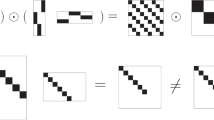Abstract
This paper considers the estimation of the parameters of a linear discrete-time system from noise-perturbed input and output measurements. The conditions imposed on the system are fairly general. In particular, the input and output noises are allowed to be auto-correlated and they may be cross-correlated as well. The proposed method makes use of an instrumental variable (IV)-vector to produce a covariance matrix that is pre- and postmultiplied by some prechosen weights. The singular vectors of the so-obtained matrix possess complete information on the system parameters. A weighted subspace fitting (WSF) method is then applied to the aforementioned singular vectors to consistently estimate the parameters of the system. The IV-WSF technique suggested herein is noniterative and easy to implement, and has a small computational burden. The asymptotic distribution of its estimation errors is derived and the result is used to motivate the choice of the weighting matrix in the WSF step and also to predict the estimation accuracy. Numerical examples are included to illustrate the performance achievable by the method.
Similar content being viewed by others
References
B. D. O. Anderson and M. Deistler, Identifiability in dynamic errors-in-variables models,Journal of Time Series Analysis 5: 1–13, 1984.
S. Begheli, R. P. Guidorzi, and U. Soverini, The Frisch scheme in dynamic system identification,Automatica 26(1):171–176, 1990.
G. H. Golub and C. F. van Loan,Matrix Computations, The Johns Hopkins University Press, Baltimore, MD, second edition, 1989.
L. Ljung,System Identification: Theory for the User, Prentice-Hall, Englewood Cliffs, NJ, 1987.
K. Mardia, J. Kent, and J. Bibby,Multivariate Analysis, Academic Press, London, 1979.
T. Söderström, Identification of the stochastic linear systems in presence of input noise,Automatica, 17:713–725, 1981.
T. Söderström and P. Stoica,Instrumental Variable Methods for System Identification, Springer-Verlag, Berlin, 1983.
T. Söderström and P. Stoica,System Identification, Prentice-Hall International, London, 1989.
P. Stoica and M. Cedervall, An Eigenvalue-based detection test for array signal processing in unknown correlated noise fields, in:Proc. of the 13th World Congress of IFAC, July 1996, San Fransisco, CA, to be published.
P. Stoica, M. Cedervall, and A. Eriksson, Combined instrumental variable and subspace fitting approach to parameter estimation of noisy input-output systems,IEEE Trans. on Signal Process. 43(10), 2386–2397, Oct. 1995.
P. Stoica and A. Nehorai, MUSIC, maximum likelihood, and Cramér-Rao bound,IEEE Transactions on Acoustics, Speech, and Signal Processing, ASSP-37(5):720–741, May 1989.
P. Stoica and A. Nehorai, Performance study of conditional and unconditional direction-of-arrival estimation,IEEE Transactions on Signal Processing, SP-38(10):1783–1795, Oct. 1990.
P. Stoica and K. C. Sharman, Maximum likelihood methods for direction-of-arrival estimation,IEEE Transactions on Acoustics, Speech, and Signal Processing, ASSP-38(7):1132–1143, July 1990.
S. van Huffel and J. Vandewalle,The Total Least Squares Problem: Computational Aspects and Analysis, SIAM, Philadelphia, PA, 1991.
P. E. Wellstead, An instrumental product moment test for model order estimation,Automatica, 14:89–91, 1978.
K. M. Wong, Q. Wu, and P. Stoica, Application of generalised correlation decomposition to array processing in unknown noise environments, in S. Haykin, editor,Advances of Spectrum Analysis and Array Processing, vol. III, Prentice-Hall, Englewood Cliffs, NJ, 1995.
Q. Wu and K. M. Wong, Estimation of the directions of arrival of signals, in:Acoustic Signal Processing for Ocean Exploration, J.M.F. Moura and I.M.G. Lourtie, eds, Kluwer Academic Publisher, Dordrecht, Germany, 1993.
Q. Wu, K. M. Wong, and J. P. Reilly, Maximum likelihood estimation for array processing in unknown noise environments, inProc. of International Conference on Acoustics, Speech, and Signal Processing, vol. 5, 241–244, Mar. 1992.
P. Young,Recursive Estimation and Time Series Analysis, Springer-Verlag, Berlin, 1984.
P. Young, A. Jakeman, and R. McMurtrie, An instrumental variable method for model order identification,Automatica, 14:281–294, 1980.
Author information
Authors and Affiliations
Additional information
This work has been supported by the Swedish Research Council of Engineering Sciences under contract 93-669 and by the Göran Gustafsson Foundation.
Rights and permissions
About this article
Cite this article
Cedervall, M., Stoica, P. System identification from noisy measurements by using instrumental variables and subspace fitting. Circuits Systems and Signal Process 15, 275–290 (1996). https://doi.org/10.1007/BF01183780
Received:
Accepted:
Issue Date:
DOI: https://doi.org/10.1007/BF01183780




